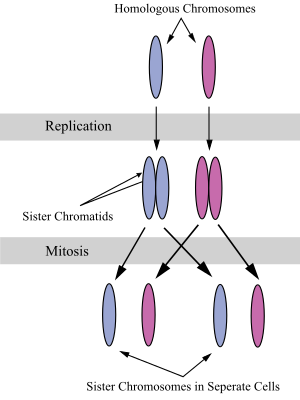โครโมโซมคู่เหมือน (อังกฤษ: homologous chromosomes, homologs) คือคู่ของโครโมโซมที่เซลล์ได้รับมาจากฝั่งพ่อและฝั่งแม่และมาจับคู่กันในขั้นตอนการปฏิสนธิ มียีนเดียวกันในตำแหน่งเดียวกันของโครโมโซม ทำให้โครโมโซมคู่เหมือนนี้สามารถจับคู่กันได้พอดีก่อนที่จะแยกกันในกระบวนการแบ่งเซลล์แบบไมโอซิส

โครโมโซมคู่เหมือนมีตำแหน่งของยีนตรงกัน แต่ไม่ได้มีลำดับเบสเหมือนกันทุกประการ ถือเป็นผลผลิตจากการปฏิสนธิ และอาจถือเป็นภาวะปกติของเซลล์สิ่งมีชีวิต ต่างจากโครโมโซมคู่พี่น้องซึ่งเป็นการทำซ้ำโครโมโซมอันเดิม ด้วยกระบวนการการถ่ายแบบดีเอ็นเอเพื่อเตรียมแบ่งเซลล์แบบไมโทซิส ซึ่งมีลำดับเบสเหมือนกันทุกประการ[1]
อ้างอิง
Wikiwand in your browser!
Seamless Wikipedia browsing. On steroids.
Every time you click a link to Wikipedia, Wiktionary or Wikiquote in your browser's search results, it will show the modern Wikiwand interface.
Wikiwand extension is a five stars, simple, with minimum permission required to keep your browsing private, safe and transparent.
